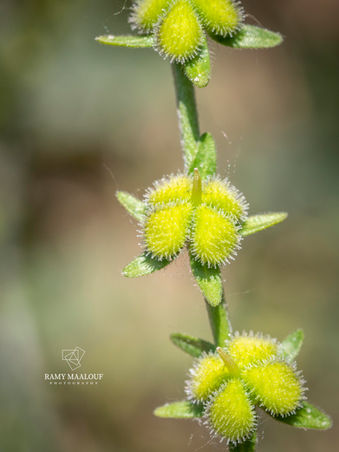Family |
Boraginaceae
Cynoglossum nebrodense
Guss.
Cynoglossum nebrodense Guss.
(Fl. Sicul. Prodr. 1: 216; 1827 – Nouvelle Flore du Liban et de la Syrie, vol. 2, Pl. CLXXIX nº 3; 1969)
• Life-form & habit: Perennial herb with a thick, branched rootstock and ascending to erect stems 30–60 cm tall, densely clothed in coarse, appressed hairs giving a greyish-green appearance.
• Leaves: Basal leaves oblanceolate, 8–20 × 1.5–3 cm, tapering into a short petiole; cauline leaves alternate, sessile, lanceolate, progressively smaller upward, both surfaces covered with stiff, appressed hairs. Texture firm, upper surface dull green, lower surface whitish.
• Inflorescence & flowers: Inflorescence a dense, leafy scorpioid cyme that elongates in fruit, with numerous pedicellate flowers. Calyx deeply 5-partite, lobes linear-lanceolate, enlarging in fruit. Corolla funnel-shaped, 5–7 mm wide, bright blue to sky-blue, with rounded lobes and a whitish eye; fornices small, erect; stamens included, anthers oval, inserted near the corolla throat.
• Fruit: Nutlets four, depressed-globose, 3–4 mm in diameter, covered with hooked glochidia, strongly reticulate and spreading at maturity; gynobase flat.
• Phenology: Flowers from May to July; fruits mature from July to September.
• Habitat & elevation: Dry montane grasslands, rocky slopes, and open juniper or pine clearings, between 1 400 and 2 400 m; prefers well-drained, calcareous soils in sunny exposures.
• Lebanese distribution: Recorded by Mouterde from Mount Sannine, Ehden, and Barouk, growing on limestone slopes and subalpine pastures.
• Native to: Italy, Lebanon-Syria, Sicilia, Spain (POWO).
• ⚠️ Taxonomic note:
According to Mouterde (1969):
“This Middle Eastern plant was classified by Boissier (1879: 265), and widely followed by subsequent floras, but contradicted by Brand (1921), who applied to it the rather awkward name C. montanum subsp. extraeuropaeum var. asiaticum. When compared to the European C. montanum, my material proved entirely different, showing no resemblance whatsoever, and on the contrary was very consistent with two authentic specimens of C. nebrodense collected by Todaro in the Madonie Mountains of Sicily (Tillet Collection). It may differ slightly by having fruiting pedicels that are erect-spreading rather than spreading-reflexed.”











